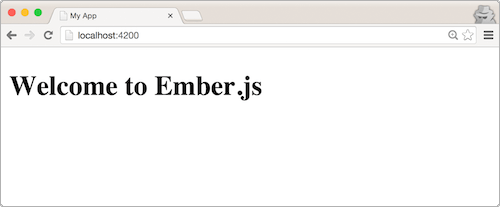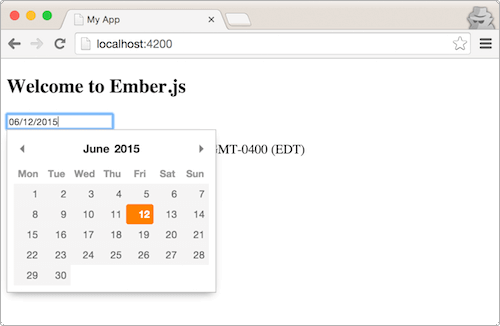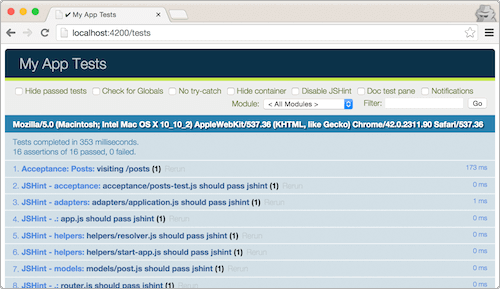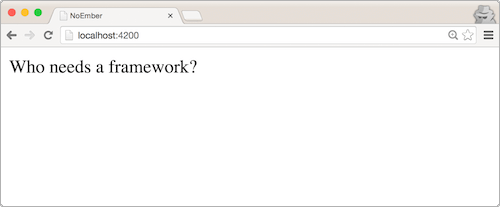If you begin a contemporary internet undertaking or begin digging into an current code base, chances are high you’re attempting to create or improve a characteristic to your customers. The final thing you need to do is spend time customizing construct instruments and creating infrastructure to develop your software. For those who land a brand new shopper, you wish to present them options at present, not in every week after you’ve cobbled collectively a construct pipeline.
As you may already know, Ember1 is an “opinionated” JavaScript net framework targeted on constructing formidable, wealthy consumer net purposes. Technologically, Ember has positioned itself because the antidote to hype fatigue2. It’s a framework that just won’t die3, however retains urgent on with each innovation4 and with a dedication to backwards-compatibility.
Ember CLI415 is the Ember group’s shared answer for front-end tooling. It offers a productive and feature-rich growth expertise out of the field.
The Problem Of Trivial Decisions Link
On the face of it, front-end construct instruments seem too various for a shared resolution. There are too many components to account for, and each mission has its personal specials wants. As acknowledged on React’s documentation web page for “Tooling Integration6,” “Each undertaking makes use of a unique system for constructing and deploying JavaScript.”
Are you utilizing Rails or .NET? What CSS preprocessor are you utilizing? Does your utility encompass a single web page or “islands of richness”? Are you utilizing JavaScript globals, asynchronous module definition (AMD), common module definition (UMD), CommonJS or ECMAScript 6 modules? What testing framework do you favor?
As a result of builders’ wants differ a lot, low-level construct instruments comparable to Gulp, Grunt and Broccoli are sometimes the start line for front-end growth. Yeoman, Lineman and Brunch take us additional by producing the boilerplate wanted for varied use circumstances.
So, how is Ember CLI totally different? By making Ember CLI the official construct software for Ember, the neighborhood will get a default suite of instruments which can be built-in by 225 Ember CLI contributors and battle-tested across the clock by the Ember person group. These instruments present helpful conventions, clear paths to finest practices, and escape from the burden of trivial choices7. As Chris Eppstein tweeted8, referring to the Sass language, “It’s our perception that this consistency promotes a vibrant ecosystem and that it’s a much bigger profit than the ‘excellent for me’ method.”
Some builders may discover it tough to surrender selection in favor of productiveness. I argue that we should turn out to be specialists within the area wherein we work and, for many builders, that area is the intersection of the consumer’s enterprise and maintainable utility growth. Frankly, I’ve by no means heard of a growth workforce that created construct instruments they had been pleased with. Nonetheless, I’ve seen customized construct instruments be disastrous for initiatives. It’s best to attempt Ember CLI earlier than trying to construct your individual.
New Alternatives Link
Ember CLI isn’t nearly constructing property higher than earlier than. When a group coalesces round a expertise, new alternatives for productiveness emerge. Listed here are a number of improvements which have change into potential with Ember CLI.
- Ember Addons9
These are libraries that may be put in in an Ember CLI utility and that “simply work” with zero configuration. - Ember CLI Deploy10
That is for typical front-end deployment. - Ember FastBoot11
Render Ember purposes on the server for quicker preliminary web page load.
One other facet impact of Ember CLI is that builders obtain the newest and best expertise, with out even needing to realize it exists. Out of the field, Ember CLI functions have ECMAScript transpilation with Babel12, dwell reloading throughout growth, and a easy technique to proxy AJAX requests to an area or distant server.
Let’s Create An Ember App Link
Earlier than creating an Ember CLI app, you’ll want to put in Node.js. Yow will discover out how one can set up it on the Node.js website13, or you need to use the favored Homebrew14 mission in case your laptop runs Mac OS X:
brew install nodeSubsequent, set up Ember CLI itself:
npm install -g ember-cliWith the conditions out of the best way, you’re able to create your first Ember software:
ember new my-appAs soon as that’s completed, transfer to your app’s listing (cd my-app), run your app with ember serve, and go to localhost:4200 to see your software in motion.
 15
15Utilizing Ember CLI Link
Utilizing the blueprints characteristic of Ember CLI, let’s add some meat to our app and present an inventory of posts when a consumer visits the /posts URL. You can too comply with alongside within the accompanying GitHub repository17.
ember g resource posts title:string body:stringThis tells Ember CLI to generate a posts useful resource — it creates a route entry in your router, a route, a posts template and a put up mannequin. The submit mannequin may have title and physique attributes which might be solid to strings.
We’ll must loop by means of our posts and render them in our posts template. The every helper makes this doable in app/templates/posts.hbs.
#each model as
<h3>post.title</h3>
<hr>
post.body
/each
Subsequent, we’ll need to discover our posts’ information and hand it off to the template when the consumer visits /posts. We’ll fetch the posts within the mannequin hook of our posts route, positioned at app/routes/posts.js.
export default Ember.Route.extend(
// Add this method
model()
return this.store.findAll('post');
);
You may discover that we’ve used ECMAScript 6’s shorthand syntax for objects18 to outline the mannequin technique. As a result of Ember CLI makes use of a JavaScript transpiler19 by default, anticipate to see trendy JavaScript code in most Ember purposes.
We might have simply written some JavaScript objects for the put up knowledge in our route right here and referred to as it a day, however let’s go a bit of additional and truly fetch posts from a server.
We’ll generate an Express20 internet server to serve up some knowledge to our utility.
ember g http-mock postsThen, we’ll return some dummy information from /api/posts. Edit the generated server/mocks/posts.js file to return some knowledge from the index route.
postsRouter.get('/', function(req, res)
res.send(
'posts': [
// Add these objects
id: 1, title: 'First Post', body: 'Blogging' ,
id: 2, title: 'Second Post', body: 'Blogging again'
]
);
);
The very last thing we’ll want is a personalized Ember Data21 adapter.
ember g adapter applicationTo ensure Ember Knowledge is aware of to search out the posts at /api/posts, we’ll add a namespace to our adapter in app/adapters/utility.js.
export default DS.RESTAdapter.extend(
namespace: 'api' // Add this
);
Now, if you happen to go to localhost:4200/posts, you will note the posts in all their glory.
 22
22In fact, you’ll in all probability wish to hook up your software to an actual net server sooner or later within the growth course of. While you’re prepared, you may take away the mock server and run your app with the proxy possibility:
ember s --proxy http://localhost:3000On this command, change http://localhost:3000 together with your native or distant net server.
It is a nice strategy to construct your entrance finish instantly and transition to a manufacturing internet server later.
Utilizing Ember Addons Link
In the event you’re acquainted with utilizing Bower24 and npm25 to put in dependencies, then Ember Addons may impress you.
Let’s set up and use a date-picker in our Ember app. My date-picker of selection is Pikaday26. Fortunately, a number of folks have already built-in this library with Ember CLI. Right here, we’ll use the ember-pikaday addon.
ember install ember-pikadayNow, let’s create a file at app/templates/index.hbs and take a look at it out.
pikaday-input value=date format='MM/DD/YYYY'
<p>You picked: date</p>
 27
27This addon put in Pikaday and Moment.js29, it offered an Ember part named pikaday-input, and it included the Pikaday CSS in our construct — all with a single set up command.
Testing Link
Integrating your utility code, a testing framework and a take a look at runner may be difficult. You’ll need to run unit assessments towards remoted elements of the code and built-in assessments in opposition to the operating software. You’ll additionally need to run exams from the command line for continuous-integration testing on a construct server.
Let’s write a check for the posts web page that we made earlier. We’ll begin by producing an acceptance take a look at referred to as “posts.”
ember g acceptance-test postsNow, you may go to http://localhost:4200/tests to see the working take a look at.
 30
30We have already got 16 checks? That’s proper. Our turbines from earlier every created a check to assist us get began, and every of our information was examined with JSHint for errors.
Let’s fill out the generated acceptance check with one thing that tells us that every one of our posts are rendered.
test('visiting /posts', function(assert)
visit('/posts');
andThen(function()
var titles = find('h3').toArray().map((el) => el.textContent);
assert.deepEqual(titles, ['First Post', 'Second Post'], "Has both titles");
);
);
This take a look at begins up our Ember app in an remoted portion of the check runner, visits the posts path after which asserts that every submit title is on the web page. The andThen helper waits for asynchronous processing to cease earlier than making assertions.
In case you’re not an avid tester, you may end up operating out of excuses with Ember CLI. When you do get excited by testing, you’ll discover it simple than ever to get began. The blueprints put present greatest practices at your fingertips, so that you simply don’t need to spend time Googling “the way to check [x] in Ember.”
Going To Manufacturing Link
Earlier than delivery the code to manufacturing, you’ll need to optimize for velocity, minify the code, fingerprint your property and hyperlink these fingerprinted belongings within the index.html file.
You may accomplish all of that with a single command, which places your production-ready information into the /dist listing.
ember build --environment="production"As soon as your belongings are constructed for manufacturing, the subsequent step is to deploy them to a distant server. Many Ember CLI customers select to combine these construct information with the identical deployment course of they use for back-end server code. Nonetheless, an rising greatest follow, refined and championed by Luke Melia32, is to use a separate front-end deployment workflow that permits your Ember software to be deployed independently of your server code.
At EmberConf 2015, Luke announced33 that the maintainers of outstanding addons for deployment had joined forces to create one addon underneath the title Ember CLI Deploy. The newly shaped staff launched its first joint effort, model zero.5.zero of the addon.
Ember CLI Deploy embraces a “core and plugins” structure. The add-on supplies the deployment workflow, however customers set up totally different plugins in response to the precise infrastructure they use. As an illustration, one setup proposed by Luke makes use of Amazon’s S3 service to host information and Redis to retailer and hyperlink the Ember utility’s index.html file.
You possibly can set up the present addon utilizing the identical set up command we noticed earlier than:
ember install ember-cli-deployWe’ll additionally set up ember-cli-build to construct our software for manufacturing.
ember install ember-cli-buildFrom there, you’ll be able to set up the asset-adapter plugin that you just want:
ember install ember-cli-deploy-s3Then, you’ll want to put in an index-adapter plugin, which gives a method to hyperlink your index.html file to the server:
ember install ember-cli-deploy-redisLastly, you’ll be able to edit your config/deploy.js file to incorporate details about Redis and S3, in order that Ember CLI Deploy can work together with these providers.
With these adapters put in and configured, you may deploy with one command.
ember deploy production --activateThis command will:
- construct your property for manufacturing,
- add your JavaScript and CSS belongings to S3,
- add your
index.htmlfile to Redis, - “activate” the final
index.htmlfile that was uploaded.
On this sequence of occasions, solely the final step, activation, modifications the model of the Ember utility that’s served to customers. Earlier variations of index.html are saved on Redis, and former variations of your property are saved on S3. To change the model of the working Ember utility, builders use the activate command to inform their server to make use of a specific index.html file that’s pointing to single set of belongings saved on S3.
ember deploy:activate production --revision 44f2f92To study extra about how one can deploy an Ember utility together with your infrastructure, checkout the documentation for ember-cli-deploy34.
Not Simply For Ember Link
All of that speak about eliminating trivial selections might need left you with the impression that Ember CLI isn’t versatile or configurable. As a result of Ember CLI must accommodate a variety of use instances from the neighborhood, it has a well-defined public interface for personalization. The truth is, regardless of the identify, Ember isn’t a requirement for Ember CLI. As an illustration, the Firefox OS staff has used Ember CLI with an addon that it created35, somewhat than create its personal construct software.
Suppose you need all the great options of Ember CLI with out Ember. Once more, you may observe alongside within the accompanying GitHub repository36 in case you like. We’ll begin with a brand new Ember CLI utility:
ember new no-emberSubsequent, we’ll do away with Ember in order that it isn’t in our JavaScript construct. We’ll take away Ember and Ember Information from the bower.json file.
// In bower.json
…
"dependencies":
"ember": "2.2.0", // Delete
…
"ember-data": "^2.2.1", // Delete
…
,
"resolutions":
"ember": "2.2.0" // Delete
We additionally have to take away Ember Knowledge from the bundle.json file.
// In package.json
…
"devDependencies":
…
"ember-data": "^2.2.1", // Delete
…
Subsequent, let’s delete many of the issues in our utility listing. To have a working software, we solely want, types, app.js and index.html.
app/
├── app.js
├── index.html
└── styles
Ember CLI is anticipating us to export an object from app.js that has a create technique which mirrors the interface to an Ember.Utility. Let’s change the default content material in that file with a easy exported object.
export default
create()
;
Lastly, let’s create an ECMAScript 6 module that renders one thing in our software.
In app/modules/render-something.js, we’ll export a perform that renders some content material.
export default function renderSomething()
document.write("Who needs a framework?");
You possibly can put the modules wherever you need within the app listing. You’ll use the identical path when importing out of your utility’s namespace. Right here is how we are able to import and use that module in our app.js file:
import renderSomething from 'no-ember/modules/render-something';
export default
create()
renderSomething();
;
Now you’ll be able to see your net app operating at http://localhost:4200.
 37
37The Future Of Ember CLI Link
With out query, Ember CLI is right here to remain. Though the Ember group was the primary of the fashionable front-end framework communities to take construct instruments into their very own fingers, others have begun to observe suite. AngularJS 2.zero has its personal CLI device, angular-cli39, which is an Ember CLI addon. As a result of React has a narrower scope than AngularJS 2.zero or Ember, an official construct device is just not deliberate, however one thing promising will hopefully emerge from its current ecosystem of tools40.
In case you’ve been ready to offer Ember a attempt, why not begin in the present day with Ember CLI? All you must get began is that this:
npm install -g ember-cli
ember new my-first-ember-project
References Link
(rb, ml, al)
- 1 http://emberjs.com/
- 2 http://brewhouse.io/blog/2015/05/13/emberjs-an-antidote-to-your-hype-fatigue.html
- 3 https://twitter.com/wycats/status/597772107510976512
- 4 https://github.com/emberjs/ember.js/pull/10501
- 5 http://www.ember-cli.com/
- 6 https://facebook.github.io/react/docs/tooling-integration.html
- 7 https://youtu.be/9naDS3r4MbY?t=1m47s
- 8 https://twitter.com/chriseppstein/status/590211838782013440
- 9 http://www.emberaddons.com/
- 10 https://github.com/ember-cli/ember-cli-deploy
- 11 https://github.com/tildeio/ember-cli-fastboot
- 12 https://babeljs.io
- 13 https://nodejs.org/
- 14 http://brew.sh/
- 15 https://www.smashingmagazine.com/wp-content/uploads/2015/06/01-default-app-opt.png
- 16 https://www.smashingmagazine.com/wp-content/uploads/2015/06/01-default-app-opt.png
- 17 https://github.com/mitchlloyd/smashing-ember-cli-my-app/commits/master
- 18 https://babeljs.io/repl/#?experimental=true&evaluate=true&loose=false&spec=false&playground=false&code=var%20route%20%3D%20%7B%0A%20%20model()%20%7B%0A%20%20%20%20return%20this.store.find(‘post’)%3B%0A%20%20%7D%0A%7D
- 19 https://babeljs.io
- 20 http://expressjs.com/
- 21 https://github.com/emberjs/data
- 22 https://www.smashingmagazine.com/wp-content/uploads/2015/06/02-posts-opt.png
- 23 https://www.smashingmagazine.com/wp-content/uploads/2015/06/02-posts-opt.png
- 24 http://bower.io/
- 25 https://www.npmjs.com/
- 26 http://dbushell.github.io/Pikaday/
- 27 https://www.smashingmagazine.com/wp-content/uploads/2015/06/03-pikaday-opt.png
- 28 https://www.smashingmagazine.com/wp-content/uploads/2015/06/03-pikaday-opt.png
- 29 http://momentjs.com/
- 30 https://www.smashingmagazine.com/wp-content/uploads/2015/06/04-all-tests-opt.png
- 31 https://www.smashingmagazine.com/wp-content/uploads/2015/06/04-all-tests-opt.png
- 32 https://youtu.be/4EDetv_Rw5U?t=11m1s
- 33 https://youtu.be/4EDetv_Rw5U?t=18m59s
- 34 http://ember-cli.com/ember-cli-deploy/
- 35 https://github.com/mozilla/ember-cli-fxos
- 36 https://github.com/mitchlloyd/smashing-ember-cli-no-ember/commits/master
- 37 https://www.smashingmagazine.com/wp-content/uploads/2015/06/05-no-ember-app-opt.png
- 38 https://www.smashingmagazine.com/wp-content/uploads/2015/06/05-no-ember-app-opt.png
- 39 https://github.com/angular/angular-cli
- 40 https://github.com/facebook/react/wiki/Complementary-Tools#build-tools
- 41 http://www.ember-cli.com/
- 42 https://www.youtube.com/watch?v=J6vPwvFdUiE
- 43 https://www.youtube.com/watch?v=9naDS3r4MbY